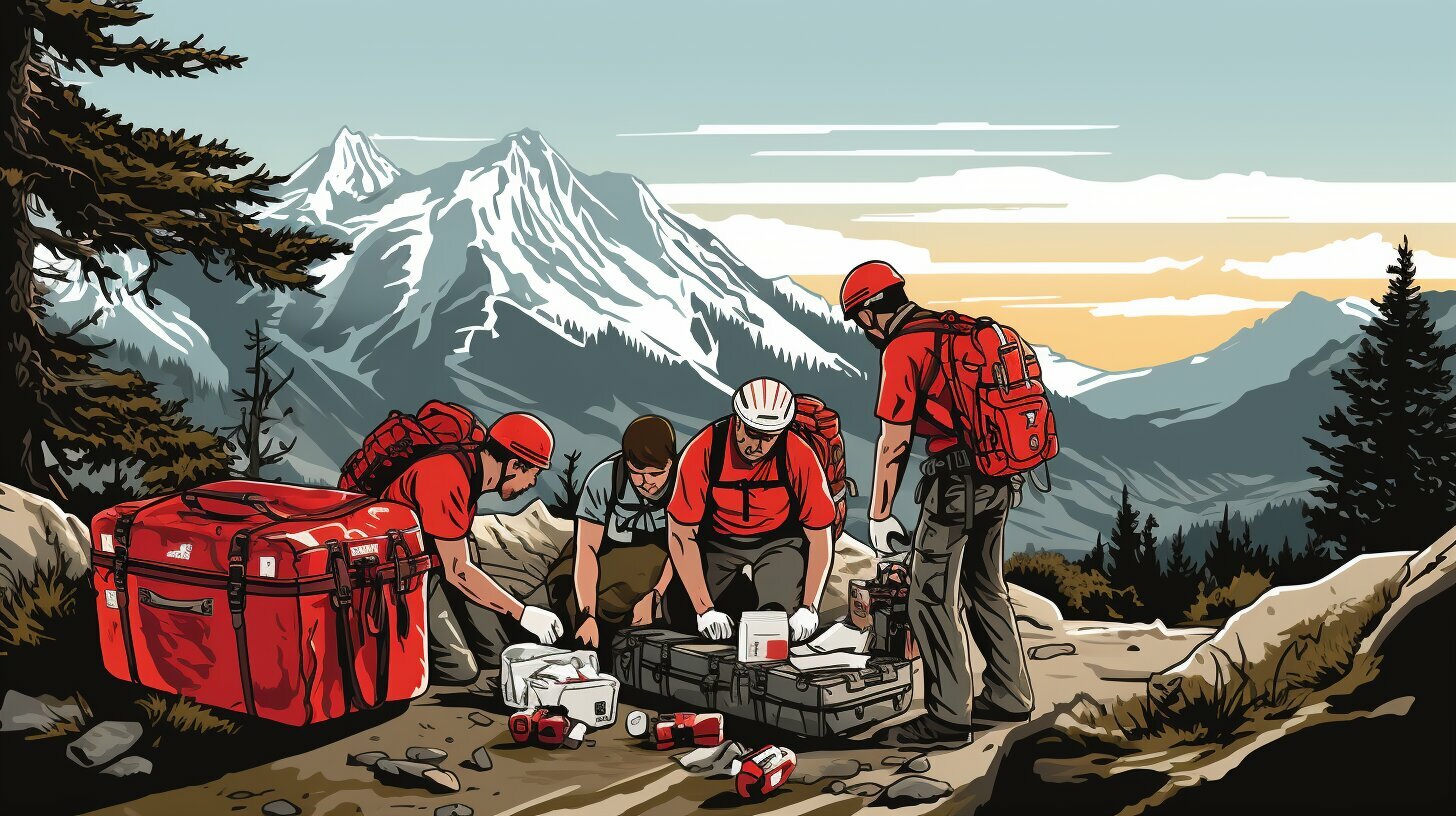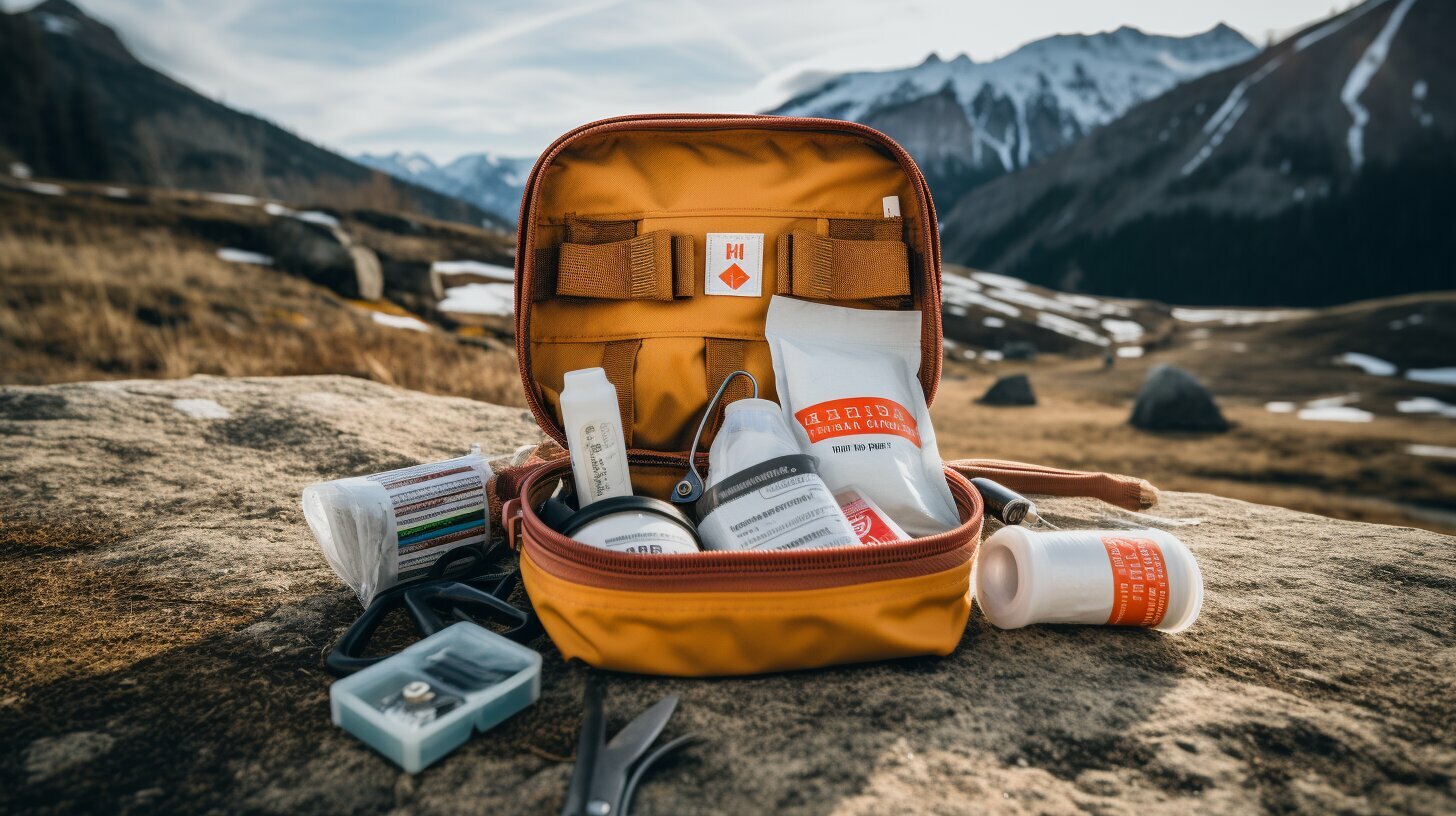When mountain climbing, it is crucial for climbers to have a well-equipped first aid kit tailored to their specific needs. Having the right emergency supplies and medical equipment can make a significant difference in managing incidents and injuries that may occur during the climb.
While pre-made first aid kits can serve as a good starting point, it is highly recommended to customize them according to individual requirements. By personalizing the kit, mountain climbers can ensure they have the necessary items to address potential challenges they may encounter on their journey.
Key essentials to include in the first aid kit are medications such as ibuprofen, paracetamol, aspirin, and Benadryl. These medications can help alleviate pain, reduce inflammation, and provide relief from common symptoms associated with climbing-related injuries or illnesses.
In addition to medications, it is important to have materials for controlling bleeding, non-latex gloves, wound cleaning supplies, trauma scissors, tape, and a paper and pencil for taking medical notes. These items can prove essential in managing injuries effectively and safely until professional medical assistance is available.
However, it is crucial to remember that having a well-stocked first aid kit should never be a substitute for proper first aid training. Climbers should consider taking wilderness first aid courses to gain the knowledge and skills required to handle emergency situations confidently and efficiently.
During mountain climbing, being able to attract attention and communicate effectively with emergency services can be vital. Climbers should be well-versed in methods of alerting others in case of emergencies and initiating contact with the appropriate authorities for assistance.
In addition to the essential items mentioned, there are other considerations that climbers should keep in mind. Items like vaseline, Elastoplast tape, tweezers, antihistamine tablets, and over-the-counter painkillers can be helpful in treating minor injuries that may occur during the climb.
While having the right supplies and equipment is crucial, it is equally important to have the necessary knowledge and training in first aid and basic life support. This will enable climbers to provide immediate care and support in critical situations that may arise during their expedition.
Furthermore, laminated emergency instructions and accident report forms can be valuable additions to the first aid kit. These resources can provide clear guidance to climbers in high-pressure situations and aid in documenting incidents for future reference.
Lastly, spare clothes should be included in the kit. They can serve multiple purposes, such as keeping casualties warm and providing protection for injured areas.
In conclusion, when mountain climbing, climbers must prioritize having a well-equipped first aid kit tailored to their specific needs. By including the essential items, obtaining proper training, and considering additional considerations, climbers can increase their preparedness and ensure they can manage incidents and injuries effectively, safeguarding their own well-being and that of their fellow climbers.
Customizing Your First Aid Kit
One essential aspect of preparing for a mountain climbing adventure is customizing your first aid kit to ensure you have the necessary supplies. While pre-made kits can be a good starting point, it is recommended to tailor the contents to meet your individual needs. This way, you can be better prepared for any incidents or injuries that may occur during your climb.
When customizing your first aid kit, there are several key items that should be included. Medications such as ibuprofen, paracetamol, aspirin, and Benadryl can help manage pain, reduce inflammation, and treat allergic reactions. It is also important to have materials to control bleeding, including gauze pads, adhesive bandages, and medical tape. Non-latex gloves are essential for protecting yourself and others when administering first aid.
Wound cleaning supplies such as antiseptic wipes or solutions, tweezers for removing splinters or ticks, and trauma scissors for cutting clothing or bandages are also important additions to your kit. Don’t forget to include a paper and pencil for taking medical notes if needed. These items will help you effectively treat minor injuries and manage more serious situations until professional medical help is available.
Customizing Your First Aid Kit: A Checklist
- Medications: ibuprofen, paracetamol, aspirin, Benadryl
- Materials to control bleeding: gauze pads, adhesive bandages, medical tape
- Non-latex gloves
- Wound cleaning supplies: antiseptic wipes or solutions, tweezers, trauma scissors
- Paper and pencil for taking medical notes
It is crucial to remember that having a well-stocked first aid kit is not a substitute for first aid training. Taking wilderness first aid courses can provide you with the necessary knowledge and skills to effectively respond to emergencies while on a mountain climb. These courses often cover topics such as attracting attention in remote areas and communicating with emergency services.
In addition to the essential items, there are other materials that can be useful for treating minor injuries during your climb. Vaseline can be applied to chafed or blistered areas for added comfort. Elastoplast tape is handy for securing bandages or providing support to sprained joints. Antihistamine tablets can provide relief from allergy symptoms, and over-the-counter painkillers can help alleviate minor aches and pains that may occur during the climb.
Additional Items for Minor Injuries
- Vaseline
- Elastoplast tape
- Antihistamine tablets
- Over-the-counter painkillers
To further enhance your preparedness, consider obtaining training in first aid and basic life support. This knowledge can be incredibly valuable in emergency situations and may make a critical difference in the outcome of an injury. Additionally, laminated emergency instructions and accident report forms can be useful to have in your first aid kit, providing clear and concise guidance in stressful situations.
Lastly, don’t underestimate the importance of spare clothes. They can serve multiple purposes, including keeping casualties warm and protecting injured areas. When packing your kit, think about the specific needs of your climbing activity and ensure that all contents are tailored to those needs.
| Customizing Your First Aid Kit Checklist | |
|---|---|
| Medications | ibuprofen, paracetamol, aspirin, Benadryl |
| Materials to control bleeding | gauze pads, adhesive bandages, medical tape |
| Non-latex gloves | |
| Wound cleaning supplies | antiseptic wipes or solutions, tweezers, trauma scissors |
| Paper and pencil for taking medical notes |

In addition to having a well-stocked first aid kit, it is crucial for mountain climbers to undergo wilderness first aid training to be prepared for any emergencies that may arise during their adventures. Knowing how to respond effectively to injuries or illnesses in remote and challenging environments can make a significant difference in the outcome of an emergency situation. Wilderness first aid courses provide climbers with the necessary knowledge and skills to assess and treat injuries, manage environmental hazards, and make informed decisions in unpredictable circumstances.
During wilderness first aid training, climbers learn techniques specific to outdoor environments, such as improvising splints, managing fractures, and treating hypothermia or heat-related illnesses. They also learn how to attract attention and communicate effectively with emergency services, considering the limited resources and communication options in remote areas. The training typically includes hands-on practice, scenario-based simulations, and discussions on topics like evacuation procedures and emergency planning. By completing wilderness first aid courses, climbers gain the confidence and competence to handle medical emergencies effectively, ensuring the safety and well-being of themselves and their climbing partners.

| Benefits of Wilderness First Aid Training | Examples of Covered Topics |
|---|---|
|
|
By investing time and effort into wilderness first aid training, mountain climbers equip themselves with the necessary skills to handle emergencies effectively. They become better prepared to handle unexpected situations that may arise while pursuing their passion for climbing in the mountains. Wilderness first aid training is an essential component of every climber’s journey, ensuring safety and well-being in challenging environments.
Additonal Items for Minor Injuries
Alongside the essential supplies, mountain climbers may find it beneficial to carry a few additional items to manage minor injuries that may occur during their climb. These supplementary items can provide added comfort and aid in the treatment of common ailments or injuries that may arise in challenging outdoor conditions. Including these items in your first aid kit can help ensure you are prepared to address minor incidents promptly and effectively.
One useful item to have on hand is vaseline, which can be used to moisturize dry or chapped skin, as well as prevent friction and blistering in areas prone to rubbing or irritation. Elastoplast tape is another essential addition, as it can secure bandages or dressings in place and provide support to strained muscles or joints. Additionally, antihistamine tablets can provide relief from allergic reactions or insect bites, while over-the-counter painkillers like ibuprofen or paracetamol can help alleviate pain or discomfort.
Additional Items for Minor Injuries:
- Vaseline: To moisturize and protect the skin.
- Elastoplast tape: To secure bandages and provide support.
- Antihistamine tablets: For allergic reactions or insect bites.
- Over-the-counter painkillers: To relieve pain and discomfort.
These additional items can serve as valuable aids in the management of minor injuries encountered during mountain climbing. However, it’s important to note that they should be used in conjunction with proper first aid training and knowledge. When in doubt, always seek professional medical advice or assistance. Now, let’s take a look at other considerations to keep in mind when assembling your first aid kit for mountain climbing.
| Item | Description |
|---|---|
| Vaseline | Moisturize and protect the skin. |
| Elastoplast tape | Secure bandages and provide support. |
| Antihistamine tablets | Relief from allergic reactions or insect bites. |
| Over-the-counter painkillers | Alleviate pain and discomfort. |
Other Considerations and Conclusion
To ensure a safe and prepared mountain climbing experience, climbers should also consider factors such as first aid training, laminated emergency instructions, and carrying spare clothes.
First aid training plays a crucial role in equipping climbers with the knowledge and skills needed to respond effectively to emergencies. By completing wilderness first aid courses, climbers can learn how to assess injuries, provide basic medical care, and make critical decisions in challenging environments. This training not only enhances their ability to handle emergencies but also increases overall safety for themselves and their climbing partners.
In addition to training, laminated emergency instructions can be a valuable resource in a first aid kit. These instructions provide clear and concise guidance on how to handle common injuries and medical situations. They are particularly useful when facing high-stress situations where quick reference is essential.
Carrying spare clothes is another important consideration for climbers. Spare clothes can serve multiple purposes, such as keeping casualties warm in cold weather, protecting injured areas from further damage, and providing makeshift bandages or slings. Being adequately prepared with spare clothing can make a significant difference in the comfort and well-being of climbers in challenging situations.
In conclusion, a well-stocked first aid kit is a vital component for mountain climbers, but it is important to remember that it is not a substitute for first aid training. Customizing the kit based on individual needs, including essential items like medications, wound care supplies, and trauma scissors, is crucial. By taking wilderness first aid courses, climbers can gain the necessary skills to handle emergencies effectively. Laminated emergency instructions and carrying spare clothes further enhance safety and preparedness. With the right knowledge, resources, and equipment, climbers can conquer challenges with confidence and ensure a safe climbing experience.
